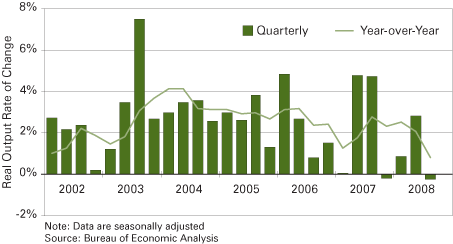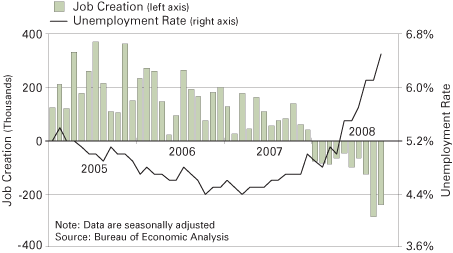U.S. Outlook for 2009
Co-Director, Center for Econometric Model Research, Indiana University Bloomington
November 2008, updated December 2008
A year ago, in our expectations for 2008, we began: “During the past year, the U.S. economy has essentially been in survival mode. The good news as the year draws to a close is that we seem to have avoided intensive care. The not-so-good news is that the impediments to full recovery are not diminishing.” That last sentence has turned out to be a masterpiece of understatement. And the next sentence—“Nevertheless, we expect the economy will avoid a crisis and continue to muddle through”—was clearly an example of misplaced optimism.
Output growth in the United States decelerated for the fourth straight year during 2008. On a fourth-quarter to fourth-quarter basis, 2008 real gross domestic product (GDP) will probably show only minimal growth. (Fourth quarter data were not available at the time of this writing.) The last time the economy approximated its long-run potential (about 3 percent growth) was in early 2006 (see Figure 1).
Figure 1: U.S. Real Output Quarterly and Annual Rate of Change, 2002 to 2008

The labor market shows a similar pattern (see Figure 2). During 2005, the economy was adding over 210,000 jobs each month. This slowed to 175,000 per month in 2006, and to 91,000 in 2007. So far this year, the economy has been losing over 170,000 jobs per month, with the rate of loss increasing as the year has proceeded. In order to absorb new entrants into the labor force (for example, young people graduating from high school or college), the economy must generate about 140,000 new jobs each month. When this is not achieved, as has been the case since early 2007, unemployment rises. During this period, unemployment has gone from a low 4.4 percent to a November level of 6.7 percent, with worse yet to come.
Figure 2: U.S. Job Creation and Unemployment Rate, January 2005 to October 2008

Three fundamental problems have contributed to this dismal performance. The starting point was the continuing implosion in the housing sector. Since peaking in late 2005, the decline has been dramatic. Housing starts, for example, have fallen by well over 50 percent, and it will probably be at least the middle of 2009 before any real improvement occurs. The weak sales environment has also become evident in housing prices, which have been under unprecedented pressure throughout the country. As a result, record numbers of homeowners face foreclosure. Moreover, since a house is the largest asset for most households, the decline in home values has dealt a severe blow to consumer confidence in general.
The second source of negative pressure is the energy market. Two years ago, oil prices were around $60 per barrel. By last summer, they had reached nearly two-and-a-half times that level. With gasoline prices piercing the $4 per gallon level, the strain on household budgets was a second and more immediate blow to consumer confidence. Even though oil prices have retraced all of this rise, and gas is below $2 per gallon, the damage to confidence has not been repaired.
Finally, since September, the financial system has been hit by a seemingly endless series of body blows—clearly the most serious threat to that core sector of the economy since the 1930s. Major commercial and investment banks have failed or been forced into “shotgun” mergers. Fannie Mae and Freddie Mac, the primary conduits for mortgage financing, have been taken over by the government, as has the country's largest insurance firm (AIG). The Federal Reserve and the U.S. Treasury have been concocting scheme after scheme to inject liquidity into the financial system, including direct purchases of bank equity by the government. Even so, lending has slowed to a crawl, with direct effects on both consumer and business investment. And last but not least, values in both the stock and bond markets have cratered. All of this is a third blow to consumer (and business) confidence.
With consumers and businesses cautious about their spending, there are only two potential sources of forward momentum: government and the foreign sector. The former is constrained by budget deficits, while the latter is feeling the impact of the financial crisis right along with us.
In the face of all this, it is not surprising that the economy shifted into reverse gear in the third quarter. Unfortunately, we think the worst is still ahead.
- We expect output to decline through the first half of 2009. Growth will return in the second half of the year, leaving year-end output about flat at the end of 2008. During the recession, output will decline by more than 1 percent.
- Employment will decline by well over two million from the beginning of 2008 through the end of the recession. This will drive the unemployment rate above 7.5 percent, perhaps substantially.
- Inflation will decline from elevated levels during 2008, with an assist from much lower energy prices. Weak demand for both inputs and outputs will also cause price increases to moderate.
- The Federal Reserve, which lowered its target for the federal funds rate to 1 percent in October (down from 5.25 percent in fall of 2007), will reduce rates even more in 2009.
Given the series of blows that the economy has absorbed over the past six months, this is a relatively optimistic scenario. It rests on both the housing and financial markets stabilizing as the year proceeds. Neither of these outcomes is even close to a lock, and they are interconnected. The financial situation is hampering recovery in housing, and the continuing housing implosion is a root cause of the financial crisis.
As 2008 draws to an end, our hope is that we escape 2009 with only a moderate recession (similar in severity to those in 1990 and in 2001). However, we cannot rule out something worse that would compare to the severe recession in the early 1980s.
Also in this Issue…
- Outlook for 2009
- International Outlook for 2009
- U.S. Outlook for 2009
- Financial Outlook for 2009
- Housing Market Outlook for 2009
- Indiana's Outlook for 2009
- Indiana's Agricultural Outlook for 2009
- Indiana's Special Sectors Outlook for 2009
- Anderson Forecast 2009
- Bloomington Forecast 2009
- Columbus Forecast 2009
- Evansville Forecast 2009
- Fort Wayne Forecast 2009
- Gary Forecast 2009
- Indianapolis-Carmel Forecast 2009
- Kokomo Forecast 2009
- Louisville Forecast 2009
- Muncie Forecast 2009
- Richmond Forecast 2009
- South Bend and Elkhart Area Forecast 2009
- Terre Haute Forecast 2009
- Return to Table of Contents



